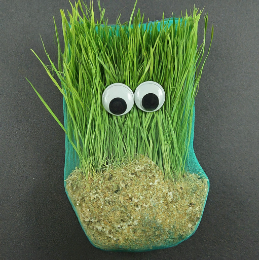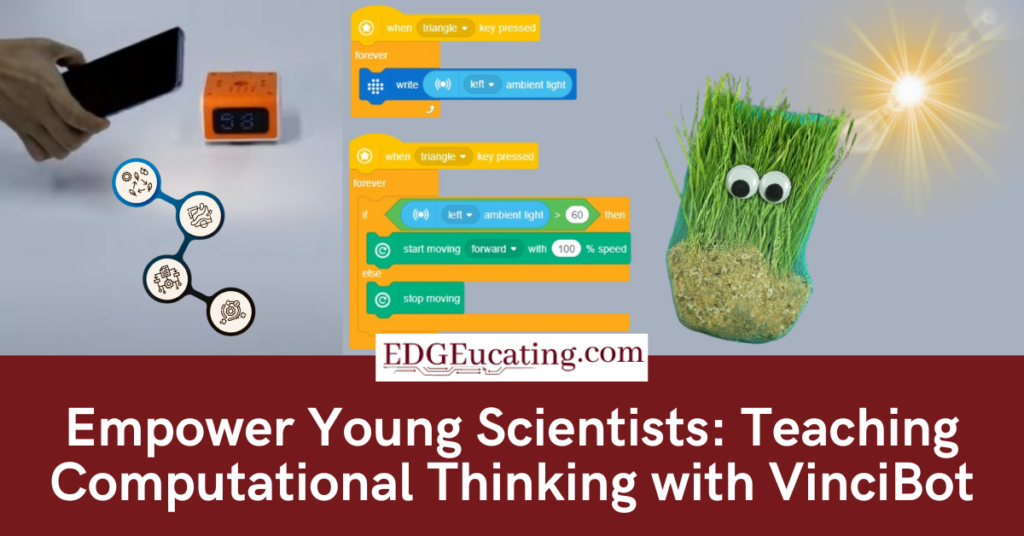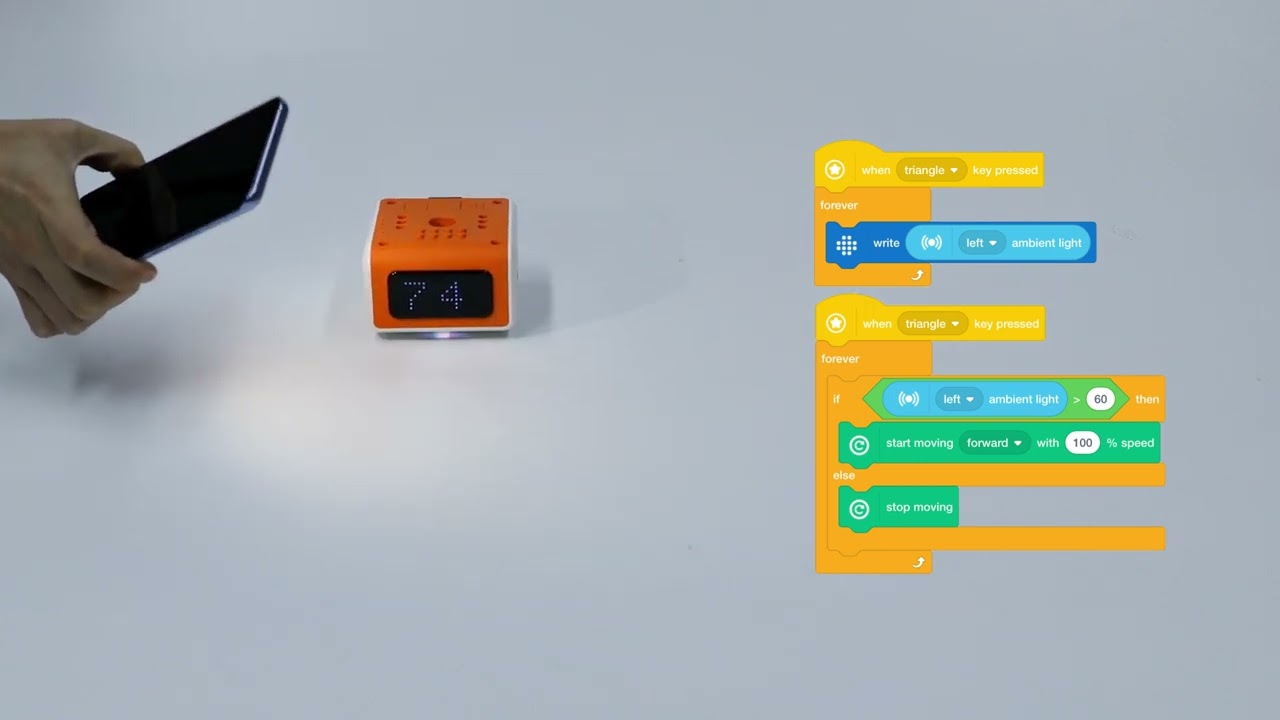As educators, we’re often tasked with introducing complex concepts in ways that are accessible, engaging, and relevant to our students. Recently, I was asked to help explain computational thinking and how it can be incorporated into the classroom to enrich student learning. Computational Thinking (CT) isn’t just for computer scientists—it’s a problem-solving approach that can enhance any subject, from math and science to reading and social studies. In this blog post, I’m excited to share a lesson idea that not only illustrates the various aspects of computational thinking but also integrates it seamlessly into a hands-on science project.
Using the Matatastudio VinciBot Classroom Set, we’ll explore how to inspire your students to become budding little scientists by giving them the tools they need to investigate the world around them. This lesson will show you how to engage students with a love for science while meeting the Next Generation Science Standards (NGSS). Specifically, we’ll look at how to use computational thinking to investigate the life science standard 2-LS2-1: determining if plants need sunlight and water to grow. By putting this into the context of a computational problem, we provide students with a dynamic learning experience that mirrors the work of real scientists.
 Computational Thinking: A Lesson Example
Computational Thinking: A Lesson Example
The Matatastudio VinciBot Classroom Set can be used to equip your students with a love for science by providing them with the tools they need to explore the world around them. This blog post will dive deeper into CT and how the VinciBot can be used to support Next Generation Science Standards (NGSS) by providing students with the opportunity to integrate computer science and computational thinking…just like a real scientist!
The focus of this post will be on the following NGSS Life Science standard for 2nd grade: “2-LS2-1: Plan and conduct an investigation to determine if plants need sunlight and water to grow.”
We are also going to deepen the learning by putting this into the context of a Computational Problem: Does a plant need sunlight and water to grow?
Next, help the students decompose the problem…not decompose it for them. For younger students who are new to the process of decomposing a problem, it is best to describe the process as breaking the problem down into smaller ‘buckets.’ Have students help generate problems that might go into each ‘bucket.’
Buckets or Subparts:
- Plant Growth:
- What types of plants might we grow and test?
- How does the absence of sunlight or water affect plant growth rate?
- Are there visible changes in plant appearance (e.g., color, size, leaf shape) when sunlight or water is limited?
- Sunlight:
- What is the optimal amount of sunlight for plant growth?
- How does the intensity of sunlight affect plant growth?
- Can plants adapt to different levels of sunlight?
- How can we design an experiment to test for the amount of sunlight?
- Water:
- What is the optimal frequency and amount of water for plant growth?
- How does the quality of water (e.g., pH, mineral content) affect plant growth?
- Can plants tolerate periods of drought or excessive watering?
- How can we design an experiment to test how the amount of water affects plant growth?
Let students know that we (the classroom learning community) are going to be designing an experiment and creating ‘Sprout Kids’ to collect data on how sunlight and water affect growth.
Material List for Creating a Sprout Kid:
- Nylon stockings
- Sawdust
- Grass seed
- Googly eyes
- Glue
- Scissors
Optional Materials:
- Markers or paint for decorating the face
- Yarn or string for hair accessories
- Small stones or pebbles for feet
Procedural Steps to Make a Sprout Kid
- Prepare the Stocking: Cut a nylon stocking to the desired length.
- Fill with Sawdust: Fill the bottom portion of the stocking with sawdust. Tie a knot to secure the sawdust.
- Add Grass Seed: Fill the remaining space in the stocking with grass seed. Tie a knot to secure the seed.
- Create a Face: Glue googly eyes onto the stocking near the top. Use markers or paint to add a mouth, nose, and eyebrows.
- Decorate (Optional): Add any additional decorations, such as yarn hair, stone feet, or other accessories.
In order to meet the NGSS standard, you will need to create two communities within your classroom. One could be called The Bright Lights and the other The Pale Palace. Depending on class size, you could also add a third community Dark Out. Let your students take ownership of the process by engaging them in naming and creating the environments for each community.
Here are some ideas for each community:
- Bright Lights: This community could be a sunny windowsill or a spot with bright, indirect light.
- Pale Palace: This community could be a dimly lit room or a spot with filtered light.
- Dark Out: This community could be a completely dark closet or a covered container.
By placing the Sprout Kids in these different communities, you can observe how sunlight affects plant growth, color, and overall health.

Algorithms: connections with computer science
Explain to students that scientists need to be as accurate as they can when collecting data. In order for students to ensure that direct light is available in each community, students could program the VinciBot to do this work for them. Here’s a fun and engaging way to use VinciBot to guide students in placing their Sprout Kids in the correct communities:
- Program VinciBot:
- Use the Matatalab coding blocks to program VinciBot to move forward a certain distance.
- Add a light sensor block to the program.
- Set a condition: If the light sensor detects low light, VinciBot turns right. If it detects high light, VinciBot turns left.
- Set Up Communities:
- Place the three communities (Bright Lights, Pale Palace, and Dark Out) in different areas of your classroom or outdoor space.
- Ensure that each community has a distinct level of light (high, low, or no light).
- Start the Experiment:
- Give each student a Sprout Kid and a VinciBot.
- Instruct students to place their VinciBot at a starting point.
- Have students program their VinciBot to follow their Sprout Kid to the correct community based on the light sensor readings.
Example: Here is a coding example.
- If a student’s Sprout Kid needs to go to the Dark Out community, the VinciBot should be programmed to turn left whenever it detects low to no light (set value).
- If a student’s Sprout Kid needs to go to the Bright Lights community, the VinciBot should be programmed to turn right whenever it detects high light (set value).
By using VinciBot in this way, students can have a hands-on and interactive experience learning about light and its impact on plant growth. It also provides an opportunity for students to practice programming and problem-solving skills.
Data Collection & Abstraction:
Data is an essential part of computational thinking, and it goes hand-in-hand with abstraction. By analyzing the data for patterns, you abstract out the main ideas/generalizations. You in essence, simplify the complex data into something that is more easily understood.
Here is an example of a data collection tool. Students in 2nd grade should be exposed to collecting data using Google Sheets or Microsoft Excel. Allow your 2nd graders to help create the criteria for data collection with your guidance.
Patterns that might be found:
Bright Lights Community:
- Height of tallest sprout: Sprouts in this community might exhibit the tallest growth due to ample sunlight, which is essential for photosynthesis.
- Number of sprouts: There might be a higher number of sprouts in this community due to the favorable growing conditions.
- Observational data: Sprouts might have a healthy green color, strong stems, and robust growth.
Pale Palace Community:
- Height of tallest sprout: Sprouts might grow to a moderate height compared to the Bright Lights community, as they have access to some sunlight.
- Number of sprouts: The number of sprouts might be lower than in the Bright Lights community due to the reduced sunlight.
- Observational data: Sprouts might have a paler green color or exhibit signs of stretching toward the light source.
Dark Out Community:
- Height of tallest sprout: Sprouts in this community might experience minimal growth or even die due to the lack of sunlight.
- Number of sprouts: There might be few or no sprouts in this community.
- Observational data: Sprouts might appear weak, pale, or etiolated (stretched and spindly).
Abstractions: All these patterns lead to the main idea of LS2.A: Interdependent Relationships in Ecosystems. Plants depend on water and light to grow.
You now have a strong project-based lesson that incorporates the 4 elements of computational thinking (decomposition, pattern recognition, abstraction, and algorithms).
Deepen Understanding By Integrating Computational Thinking
Incorporating computational thinking into your classroom doesn’t have to be a daunting task—it can be as simple as reframing a traditional science experiment to include problem-solving strategies like decomposition, pattern recognition, abstraction, and algorithmic thinking. The Matatastudio VinciBot Classroom Set provides an exciting and practical way to do just that, allowing students to engage with technology while exploring key scientific concepts.
Through the “Sprout Kid” experiment, students not only learn about the essential needs of plants but also gain valuable experience in designing experiments, collecting and analyzing data, and using technology to solve real-world problems. By encouraging students to decompose the problem of plant growth, recognize patterns in their data, abstract the key findings, and create algorithms to guide their VinciBots, we’re equipping them with skills that are crucial for their academic and personal development.
For educators looking to deepen their understanding of how to integrate computational thinking across the curriculum, there are excellent resources available. The Blue-Bot Curriculum developed using ISTE’s 5E CT model, is a fantastic starting point. It provides a comprehensive approach to teaching computational thinking through hands-on activities that align with educational standards. Additionally, Heidi Williams’ book, No Fear Coding: Computational Thinking Across the K-5 Curriculum, is an invaluable resource that offers practical strategies for embedding computational thinking into everyday lessons.
Finally, if you’re looking for a quick and engaging way to introduce computational thinking to your students, these free lessons, “Where is the Square?” and “Equitable Playgrounds For ALL!”, are great resources. You can easily incorporate Vincibot with the Square lesson by having students draw a square. These are simple yet effective activities that help students develop their computational thinking skills while having fun with geometric shapes and affective skills development.
This lesson with the VinciBot is just one example of how you can bring computational thinking to life in your classroom. With the right tools and resources, like the VinciBot, the Blue-Bot Curriculum, and Heidi Williams’ comprehensive guide, you can inspire curiosity, foster creativity, and build a strong foundation in both science and computer science. I hope this lesson encourages you to explore new ways of integrating computational thinking into your teaching, helping your students develop the skills they need to thrive in our increasingly technological world.




